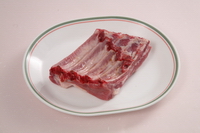
Food Safety Focus (30th Issue, January 2009) – Incident in Focus
Dioxins in Irish Pork
Reported by Dr. Anna S. P. TANG, Scientific Officer,
Risk Assessment Section,
Centre for Food Safety
On 6 December, 2008 , the Government of Ireland recalled from the market all Irish pork products produced from pigs slaughtered in Ireland from 1 September 2008 , after laboratory results of animal feed and pork fat samples obtained by the Food Safety Authority of Ireland (FSAI) confirmed high levels of dioxins. This article provides more information on dioxins contaminations in foods.
Illustration: Pork ribs 
What are Dioxins?
Dioxins are a group of persistent environmental pollutants resulting from various industrial processes and combustion activities. A number of structurally and chemically similar chlorinated compounds including polychlorinated dibenzo-para-dioxins (PCDDs), polychlorinated dibenzofurans (PCDFs), and certain dioxin-like polychlorinated biphenyls (PCBs) with similar toxic properties are together classified as "dioxins and dioxin-like compounds". The term dioxins used below refer to above group of dioxins and dioxin like compounds. Since these pollutants are found ubiquitously throughout the world, all people have background exposure and a certain level of dioxins in the body.
How Do Dioxins Get Into Foods?
Deposition of dioxins present in the atmosphere, application of pesticides and spreading of contaminated sewage may pollute water, sediments, soils, plants, feeds, and accumulate in body tissues in terrestrial and aquatic animals via the food chain. In the current incident, the cause of dioxins contaminations in pork was found to be the use of contaminated animal feed. For most people, about 90% of overall exposure to dioxins may be from diet. Food of animal origin (e.g. meat, poultry, fish, milk, eggs and their products) is the predominant source of human exposure to dioxins. Since dioxins tend to accumulate in animal fat, foods that are rich in animal fats may contain higher levels of dioxins.
Effects of Dioxins on Human Health
Short-term exposure of humans to high levels of dioxins could lead to the development of chloracne (a skin disease), excessive body hair and other skin lesions such as skin rashes and skin discolouration. Exposure to food products of contamination to such an extent is uncommon nowadays. The International Agency for Research on Cancer (IARC) has classified 2,3,7,8-tetrachlorodibenzo-para-dioxin (TCDD), the most toxic dioxin compound, as human carcinogen. Animal studies showed that long-term exposure to dioxins may affect the immune system, reproductive function, endocrine system and the developing nervous system. Associations with diabetes, thyroid dysfunction and heart diseases in humans have been reported in some studies.
Tolerable Intake Level
Considering the long half-lives of dioxins and dioxin-like compounds, ingestion each day may have a small or even negligible effect on overall intake. In order to assess health risk, the Joint Food and Agriculture Organization / World Health Organization Expert Committee on Food Additives (JECFA) considered that tolerable intake for these compounds should be assessed over a period of at least one month, hence a provisional tolerable monthly intake of 70 pg WHO-TEQ (toxic equivalent) / kg body weight was established. Occasional short-term exposure above this tolerable intake would have no health consequences provided the average intake over a long period is not exceeded.
EFSA Risk Assessment
In response to this incident, the European Food Safety Authority (EFSA)
was requested to carry out a risk assessment for human health related to the possible presence of dioxins in Irish pork and pork products. EFSA considered that contamination of dioxins only occurred over a short period of time. Although the tolerable intake level might be exceeded within this short period, there would be no health concern for this single event for an average consumer over the long term.
Key Points to Note:
- Dioxins are a group of highly toxic environmental pollutants which tend to accumulate in the food chain.
- Dioxins are concentrated in fats. Consumers may reduce dioxins intake from foods by reducing intake of animal fat in the diet.
- Short-term excursion above tolerable intake level would have no health consequences provided the average intake over a long period is not exceeded.
Control of Dioxins in Foods in Hong Kong
The Public Health and Municipal Services Ordinance (Cap. 132) stipulates that all food for sale in Hong Kong must be fit for human consumption. The Food and Environmental Hygiene Department has been monitoring dioxins in foods as part of the Food Surveillance Program since 1999. When elevated levels of dioxins are found, risk assessment and follow-up actions will be taken.
Of the 341 food samples tested for dioxins from 2006 to 2008, the results were all satisfactory.
Advice to Consumers
Consumers may reduce dietary intake of dioxins by:
- maintaining a balanced diet so as to minimise excessive exposure to dioxins from a small range of food items;
- trimming fat from meat and meat products avoiding the use of animal fat for food preparation and cooking;
- using cooking methods that can reduce fat (e.g. broiling, baking);
- consuming low-fat products.
Advice to the Trade
Farmers, feed and food manufacturers should:
- adopt good agricultural practices, good animal feeding practices and hygienic practices during primary production, processing, distribution and sale of food and feed;
- prevent and reduce contamination and formation of dioxins during food and feed processing
- purchaser and user of feed should pay attention to substances added to feeds and origin of feed ingredients for possible dioxins contaminations

